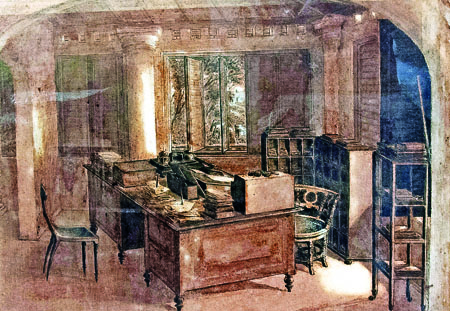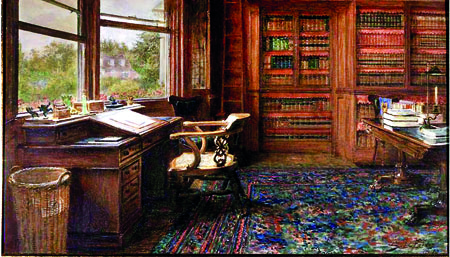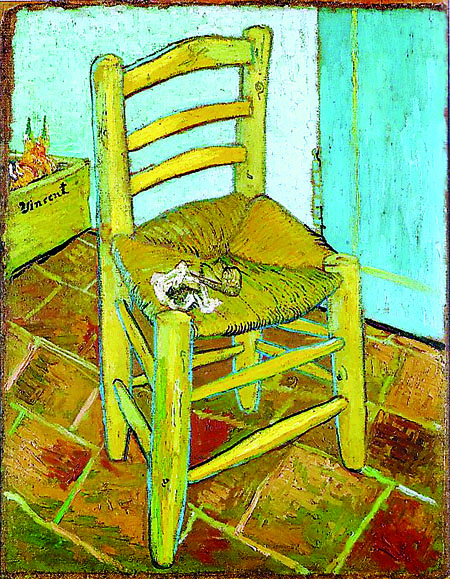A tale of three chairs: van Dort, Fildes and Van Gogh
Rudyard Kipling- famously versified the concept of the empty chair with its familiar occupant:
Ay, lay him ‘neath the Simla pine,
A fornight fully to be missed,
Behold we lose out fourth at whist
Chairs vacant where we dine.

The empty chair as depicted by van Dort
Chairs empty and vacant, anoft recurring theme in art speak of ideas and personalities. The symbolism attached to an empty throne in stone in ancient works has a long tradition. The idea of an absent occupant as in an “empty throne” existed forcenturies and this basic concept was refined over time both in the East as well as the West.
Before the advent of the anthropomorphic representation of the Buddha, devotees paid their respects to “the empty throne”or more often an image of a foot or other abstract symbols. This tradition of worship is over a thousand years old. Examples of such symbols used in religious worship are still extant in ancient Buddhist religious sites.
Both in India and Sri Lanka, “the empty throne” was often represented with a stone slab engraved and decorated laid over two massive granite supports.
But the image of the vacant seat whether as an engraving or painting in 19th century art was often expressed as an ordinary chair empty of its occupant.

The empty chair as depicted by Fildes
An artist who was taken up by this imagery was the 19th century Sri Lankan artist John Leonard Kalenberg van Dort. A leading member of the Burgher community van Dort’s lineage could be traced to the mid-17th century to an ancestor whowas in the service of the Dutch East Asiatic Company (V.O.C.) in Holland.
Befittingly the title ‘Hogarth of Sri Lanka’ could well describe this artist. From 1850 until his death in1896, he recorded every important social event with his deft sketches often bordering on caricature. His preferred medium was pen and ink or pencil and the majority of illustrations were in monochrome, intricately crosshatched and shaded, very much the product of the era.
In January 1876, van Dort painted a view of the interior of a study at the Whist Bungalow, Colombo, which he titled The Vacant Chair. The dark sepia tone work effectively captured the deserted interior of the study, in the residence of the late Sir Richard Morgan who died on the 23rd of the month.The focus of the sketch was an empty chair in Morgan’s study crowded with furniture, shelves and a vast library of books from which his client’s legal consultations were conducted.The chair’s absent occupant was the eminent lawyer Richard Morgan.
Morgan’s meteoric legal career spanned over three decades, culminating in his appointment as Acting Chief Justice. But on being offered the permanent post of Chief Justice, the highest post in the Judiciary, he excused himself on medical grounds preferring retirement.

Empty chair by Van Gogh
Morgan and van Dort were life long friends and knew each other from their schooldays at the Colombo Academy (presently Royal College), which they both attended in the late 1830s when this institution was sited in the Pettah, Colombo.
In 1870, six years before van Dort composed his sketch, a leading English artist and illustrator Luke Fildes working for one of the most influential London based newspapers of the day The Graphic published an engraving – The Empty Chair. Fildes who joined The Graphic from its inception in 1869 contributed some arresting and powerful images, during this period that depicted the socially downtrodden and the poor in an attempt to change the public’s opinion and sentiments. Many of Fildes illustrations that appeared were in black and white, popular especially among artists in Germany and France working in a social realist style addressing similar themes.
One of Fildes’ illustrations The Homeless and the Hungry was published in the first issue of The Graphic (December 4, 1869), which showed a line of poor homeless people applying for tickets to seek shelter for the night in a workhouse.This wood engraving, came to the attention of Charles Edward Millais, the artist who brought the image to the notice of Charles Dickens. The famous novelist was so impressed that he called upon Fildes and commissioned the artist to illustrate the novel he was working on -The Mystery of Edwin Drood.
Dickens who underwent such deprivation as a child due to his father’s imprisonment in the Debtors’ jail recalled his impoverished childhood, events and experiences in his novels. No doubt, Dickens shared the same sentiments in this respect as the artist.Sadly, The Mystery of Edwin Drood was to be the novelist’s last work and by June 1870, Fildes had completed 16 engravings of this serialised novel. Almost half way through the incomplete work, Dickens suffered from a stroke and died on June 9, 1870. Fildes, who was then a close friend of the family, after the funeral was invited to Gad’s Hill, Kent, the author’s residence.
Fildes vividly recalled this incident: “At the request of the family, who wished me to fulfil the desire of the great writer, they asked me after the funeral to come and stay with them, while in the house of mourning, I conceived the idea of the Empty Chair” and at once got my colours from London, and with their permission, made the water colour drawing a faithful record of his library; and stayed with them until they left the house prior to the sale”.
The wooden engraving by Fildes titled TheEmpty Chair was published in The Graphic. It was a powerfully charged image that showed an unoccupied chair in the deserted study of the great Victorian novelist Charles Dickens. It sublimely conveyed the loss of this eminent writer and effectively captured the sentiments of the public. Copies of the engraving were highly popular and were reproduced and printed several times over in other periodicals and magazines. In the following year Luke Fildes exhibited a painting based on the same theme at the annual Royal Academy Summer exhibition.
Incidentally his biography records that Vincent Van Gogh was in living in London and employed as an assistant in the branch of Goupils and Cye, a well established art gallery and dealers in European painting. Although still to embark on a career as an artist, Van Gogh was a keen and regular visitor to the Royal Academy. He deeply admired the work of Fildes and his enduring sympathy for the poor.
In a letter to his brother Theo, a few years later in July 1882 he recalled this image “I have another splendid one, a drawing by Fildes, ‘Dickens’s empty chair’ from The Graphic of 70.11. I could have bought 3 etchings by Meryon for 2 guilders for all three, but I let them go. They were good though, but I have so few etchings and want to concentrate on woodcuts.”
Somehow the illustration of The Empty Chair and its memory stayed with him and was potent a force in the depths of his visual imagination that it came to surface in his emotional frame work and the later works in oils The Chair and Pipe and Gauguin’s Chair painted in 1888 not long before he committed suicide are evidence of this.
It is remarkable that such simply composed image could evoke such a strong feeling among highly talented artists who never met each other –Felds in England, Van Gogh in France and van Dort in Sri Lanka. But in a strange manner they were distantly linked in a metaphysical way to each other –purely by this work of art.
But it is intriguing to unravel the links between Fields, Van Gogh and van Dort. As far as it has been recorded in the published biographical data on van Dort, the artist never left Sri Lanka from the day he was born in 1831 up till his death in his home Dordrecht, Bambalapitya in 1898.
Was van Dort aware of Fildes’ work? Or was it pure coincidence-I believe yes. Considering how similar in concept and detail both Fildes and van Dort’s work are in rendering this theme of the Empty Chair.
Analysing the above facts that link these two artists -here are my explanations:
There are three possible avenues by which van Dort could have accessed a copy of The Graphic in which Fildes’engraving was published and was the primary work that cast the largest influence on him.
Firstly by having a copy sent to him directly from the publishers of The Graphic. It was a magazine he was familiar with as a contributing artist in several issues published at the time
From the 1870s The Graphic employed van Dort to contribute illustrations and subjects related to Sri Lanka. It is likely he had contacts with their editorial staff who could have sent him a copy. Moreover his obituary appeared in The Graphic-so such close associations cannot be ignored.
Secondly there was a link to van Dort’s friend John Capper author, journalist and patron.Capper returned to London in 1848 for a decade, and began by contributing articles on Sri Lanka ( then Ceylon) to the early volumes of Charles Dickens’ Household Words, in which the novelist serialized his work published between 1850 and 1859. Unfortunately only the name of Dickens, the editor, appeared; articles were unsigned. Several of Capper’s books were illustrated by van Dort-including such publications. Capper’s first book regarding Ceylon was Pictures from the East (London, 1854), published in three editions between 1854 and 1900. The Duke of Edinburgh in Ceylon: A book of elephant and elk sport (London, 1871) was to commemorate Prince Alfred, the Duke of Edinburgh,Queen Victoria’s second son’s ceremonial visit here in 1870. As the Chief Editor of The Ceylon Times, aware of world events and having been within the ambit of Dickens’ literary activities he most likely would known about this engraving relating to Dickens’ last days which was published soon after the novelist’s death in June 1870 and it is also a possibility that Capper may have sent or given him a copy of the engraving by Fields. On the other hand, one cannot discount the final possibility altogether van Dort may have arrived at this concept independently- to other artists in Europe.
But the events surrounding such inter-connected art works often reveal fascinating links; it is stimulating to unravel such links and influences for any one interested in art history.


